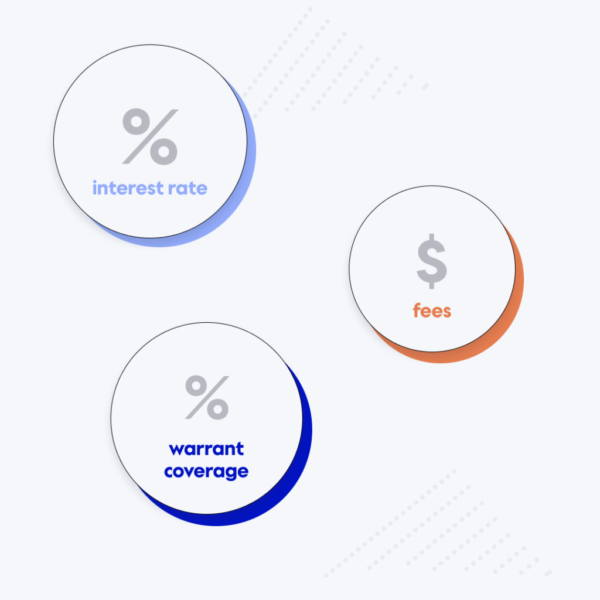Devil in the Details: Negotiating Your Debt Term Sheet
The classic startup is funded by selling founder equity, often to venture capitalists. But there’s an alternative, one that almost 50% of entrepreneurs wish they’d known about—debt or non-dilutive financing.1 With debt, founders get the upfront cash they need without giving away their equity. In 2020, lenders issued $27.5 billion in venture debt, let alone other types of debt financing.2 But when ready, how do you go about negotiating your term sheet?
Debt providers have different concerns than equity investors, and debt deals use different terminology than equity transactions. The Hum Capital investment team has issued and analyzed thousands of debt term sheets over their careers, and we have some helpful suggestions to position you for success. In this post Everardo Gomez, Managing Director at Hum and former Silicon Valley Bank VP, walks you through the key terms you’ll encounter in a term sheet, and helps you understand how to get the best terms for your business when negotiating a term sheet.
In our earlier post, we described some of the different types of non-dilutive financing that exist and the situations where one or another might be preferable. Many of these terms are common across financing vehicles. Where terms apply only to a subset of financing vehicles, we’ll let you know.
Amount Provided
Amount / credit facility:
Total amount of financing requested.
Negotiable? To a certain extent, as long as there’s a clear rationale. For instance, if you request $3 million and the bank offers $2.5 million, you can explain: “I appreciate the $2.5 million, but I really need $3 million because I’m buying equipment worth $2.5 million and need an additional $500,000 for working capital.” Don’t request a loan of $3 million just because someone else in your industry borrowed $3 million.
Advance rate:

For factoring and other accounts receivable financing, the percentage of your accounts receivable that the lender will provide. If you have a digital media company with no dilution, the advance rate may be 90%, meaning that the lender provides 90% of the sum of your accounts receivable. (Dilution refers to the amount of the invoice that you will actually pay.) If, on the other hand, you have a physical item such as furniture and you are financing inventory, the advance rate will be close to 50%, because the lender must contend with possible dilution if transit damages any products. A third possibility is that you sell lumber, rather than furniture. In that case, the advance rate on inventory financing is close to 70%, because wood is a commodity and easier to sell, but sales aren’t as certain as with digital media.
Negotiable? At the margins. The average advance rate is between 70% and 75%, but if you have very low dilution or very high-quality paying customers, you may make the case for a higher advance rate. If your product is a commodity as opposed to fashion or specialized inventory, you may also be able to get a higher advance rate.
Pricing
Interest rate:
The fee paid to a lender for borrowing capital over a given time. Be sure you understand the basis of the interest rate: is it the total amount of the loan or the outstanding balance? Also be sure you know when you start paying interest: If you start on the first day of the month or the last day, there will be a substantial difference. Generally, interest rates are expressed as APR.
Negotiable? Typically at the margin. When you get your financing through a funding platform like Hum’s Intelligent Capital Market, though, you usually get a lender’s best offer because they know they’ll be compared against their competitors who are also bidding for your business. As a result, you’ll have less need to negotiate and be able to get back to business more quickly.
Discount rate:
The interest rate used in discounted cash flow (DCF) analysis to determine the present value of future cash flows. This metric is used in factoring and RBF, where the lender provides capital based on expected future cash flows. Especially in RBF, it’s critical to understand the time period over which the discount rate is calculated and when the repayment period begins. If your revenues are higher than expected, the loan will be paid off faster than planned, raising the annual percentage rate (APR) and discount rate due to the time value of money.
Fees (upfront, termination, exit, prepayment):
Payments that accompany a loan, whether at the start or end of the period. Upfront fees can be called underwriting fees or commitment fees; termination or exit fees are payments on the back end. A prepayment fee penalizes the borrower for early repayment of a loan. In essence, a prepayment fee ensures the lender that it can make its expected return on the transaction. This can affect you if your company raises equity nine months into the life of a two-year loan and the investors want you to pay off the debt. An exit or termination fee, as you may expect, is a payment at the end of the loan regardless of whether you prepay it. For some companies, particularly startups expecting high growth, an exit fee is preferable to an upfront fee.
- Prepayments – Payments in advance of the agreed schedule. If allowed, these can reduce your interest rate. If not allowed, they can trigger prepayment penalties, as discussed above.
Negotiable? As a high-growth SaaS company, you may be able to convert an upfront fee to an exit fee on the basis that you’re a poor entrepreneur of a startup right now but have great growth prospects. An exit fee will be easier to pay because you’ll have had two years of revenue growth. It’s important to understand that exit and termination fees mean the same thing.
📓 NOTE FROM HUM
This is not uncommon in banking—if anyone uses a term you don’t recognize, ask for a definition. Banking has lots of names for the same concept. What you don’t know CAN hurt you! The Hum team regularly helps our customers review the details to make sure you understand them when negotiating a term sheet.
Borrowing base days outstanding:

For factoring, revenue-backed financing (RBF), or lines of credit based on accounts receivable, this refers to the length of time that customers have to pay your invoice, which is generally 90 – 120 days. You generally want a smaller number of borrowing base days outstanding if possible, because the loan will then have a shorter life and thus a lower interest rate.
You need to be careful if you sell an item with seasonal demand—for instance, exercise equipment or summer swimwear—the recent supply chain issues may require you to bring in a lot of inventory significantly ahead of time. Inventory-based financing always applies a larger discount to older inventory, to the extent of removing items from the borrowing base if they are more than 120 days old. If your inventory, carefully stockpiled for the seasonal rush, ages beyond 120 days, it will be removed from the borrowing base and you’ll run out of money, usually at the very time when you need to run advertisements and pay for rush deliveries. It is super-important that you tell your lender about this so you don’t surprise them.
Negotiable? Depends on the industry. You can typically negotiate the percentage of an accounts receivable loan (whether factoring, RBF, or line of credit) between 75% to 85%. The negotiation flexibility is based on “dilution” as defined above. For a SaaS company, the dilution might be the percentage of clients that don’t renew their contract or require maintenance and other unforeseen costs. If the lender assumes 20% churn but you know, based on history, it’s only 5%, you may be able to increase the total borrowing base days outstanding eligible for the loan.
📓 NOTE FROM HUM
Be sure the term sheet matches the way you do business. If your customers pay on 90 days, be sure the days outstanding term does not stipulate 60 days!
Warrants:
The right (but not the obligation) to buy a certain amount of common stock at a given price, allowing the lender to share in the company’s upside. For companies on a fast growth path that are likely to be sold or raise institutional capital, you can offer warrants in exchange for a lower interest rate. Some lenders will require them.
Negotiable? Yes. The trade-off between warrants and interest rate can be negotiated on both ends: a lower interest may require a larger warrant grant and the reverse: a higher interest rate means you grant fewer warrants.
Structure
Security:

Also called collateral, the company assets that secure the loan. In exchange for the loan, you give the lender security, or the right to some or all of the company’s assets. The security may be limited to a single piece of equipment that is acquired through the proceeds of the loan, or, with factoring, just the receivable that secures the loan. Usually, though, the security refers to all assets. If your company falls on hard times and you can’t make or reschedule your loan payments, the lender can then sell your assets to repay the debt. If a lender is unsure about the company’s financial strength, you may need to offer a personal guarantee, or a pledge of some personal assets, as part of the security.
The lender with the most senior security (also called the “first lien”), receives payment first if there is a default. Once the first lien is paid, additional money (if there is any) goes to the holders of the second liens, also known as junior or subordinated securities.
Pledge agreement:
An agreement that the company will keep a certain asset, usually intellectual property (IP), in the case of a foreclosure. With a so-called “negative pledge,” the security specifically excludes that asset. Most lenders don’t want the hassle of monetizing IP, which is time-consuming and complex, so they’d prefer to avoid any possibility of owning it. Typically, the lender uses a negative pledge to remind a struggling company to warn it before selling the IP. The company will be expected to pay the bank some of the proceeds from the IP sale.
Negotiable? In a way. You can usually carve out certain assets that are secured by a different loan (real estate or a specific piece of equipment on which you have a loan from a different lender). A smaller security pool can result in a higher interest rate. In fact, the more assets that you carve out, the less you will be able to borrow.
Reserve accounts:
For accounts receivable and inventory-based financing, part of the loan proceeds set aside as a contingency. This can work in either of two ways. In one, it’s a response to dilution, where the lender holds back a certain amount of the loan in case you do not pay the invoices in full, often due to product spoilage.
More applicable to a SaaS company, it may be an interest reserve, funds from the loan that you set aside to ensure that you can service interest. Lenders use interest reserves when a startup is pre-revenue. After one missed interest payment, which could happen because you are so insanely busy growing your business, regulations give the bank only 90 days before they must classify the loan as non-performing. Therefore, the interest reserve exists to provide additional flexibility to both the lender and the founder as the company grows.
Negotiable? Not all loans require a reserve, but for those that do, the amounts are standard, usually 10% of the loan size.
📓 NOTE FROM HUM
Lenders hate surprises, but they will often work with you to address issues if you approach them in advance. If your business has specific timing details, be sure you bring it up when negotiating the financing package. Get it written down, because lenders will forget or your representative will be promoted (because you’ve done so well and made them look so good) but if you keep in touch and have it documented, things are easier.
Use of proceeds:
What you’ll use the loan to finance.
Negotiable? In a way. The lender rarely checks to see that you used the loan for exactly the items you planned. There is no penalty if you expected to hire marketing experts and instead hired developers. It’s critical that you use it for the company’s growth, though, and not a yacht.
Key Metrics
Debt Service to Coverage Ratio (DSCR):

The ratio of debt service costs (interest and fees) to projected revenue over the loan’s life. This metric ensures there will be enough cash to cover the cost of the loan. With venture debt, the DCSR is moot, as the company will raise another equity round, but it’s critically important for other types of debt. This metric embodies the difference between the world views of lenders and investors. While investors finance a company based on its future value, lenders care about cash flow and the ability to service debt. As we say at Hum, “Debt is primarily a retrospective analysis projected forward, while equity is primarily a prospective analysis validated backward.”
Negotiable? Debt service structures can be negotiated. Negotiating the value of the DSCR itself is ineffectual, because if the company’s growth doesn’t match projections, nothing can be done. But the debt service can be structured to start low and rise as the company’s revenue streams grow. For a seasonal business, the debt service costs can be higher in peak seasons and lower in others, and the lender can structure the DSCR to accommodate that pattern.
Fixed Asset coverage (asset coverage ratio):
For accounts receivable or inventory-based financing, the ratio of the security’s value to the loan size. This metric reflects the idea that if the value of the asset on which the loan is based is falling, the size of the outstanding loan should, too. If the value of inventory is falling but the loan is not, something is wrong—margins are falling or someone is wasting cash that the company should use to pay down the outstanding loan. This ratio is an early warning sign to company management and the lender that something is amiss.
Negotiable? On the margins. If you know there’s something coming up that might affect the asset coverage ratio, be sure to warn your lender.
Minimum liquidity / remaining months liquidity:
How much cash remains, often quoted in terms of your corporate account’s cash balance. This metric is particularly important for cash-flow negative companies, because lenders use it to assess the amount of liquidity remaining.
Negotiable? If your loan agreement contains this covenant, there will be very little room for negotiation.
Performance to plan:
The degree to which your company’s results match projections. Ideally, you’re hitting all milestones you committed to and are performing to plan. You might out-perform plan, which is even better, although you may need more capital to meet demand. Companies that stay connected to a platform like Hum’s Intelligent Capital Market can receive proactive offers as their performance strengthens and they become eligible for more cost-effective financing options. Under-performing plan is clearly a problem. In that case, you need to develop a plan to improve performance. If you must change your payment arrangements on any financing, be sure to let your lender know early so you can work together.
Negotiable? The lender may require that you perform at a certain percentage of plan.
📓 NOTE FROM HUM
Deviations from planned performance⸺both positive and negative⸺may require that you revisit your financing plan and keep your lender informed.
Summing Up
The list above is only an introduction to the terms you may encounter when financing your company and negotiating a term sheet. No lender expects an entrepreneur to know all of these, so when in doubt, ask!
Remember, the lender wants you to build a high-growth, successful company. Keep them in the loop as your company grows, because they may be able to help you with products you haven’t thought of. Here at Hum, we love matching lenders and companies and ensuring that great companies keep growing.
If you’d like to explore the financing options available for your company, and the other ways Hum’s Intelligent Capital Market platform can help your company choose the right capital, just contact us at hello@humcapital.com.
Endnotes
1 Runway Growth Capital, “Runway Venture Debt Review,” October 28, 2020.
2 Pitchbook, “Q1 Pitchbook Analyst Note: Venture Debt a Maturing Market in VC,” March 2021.


